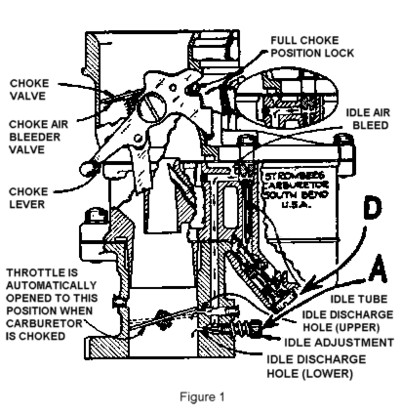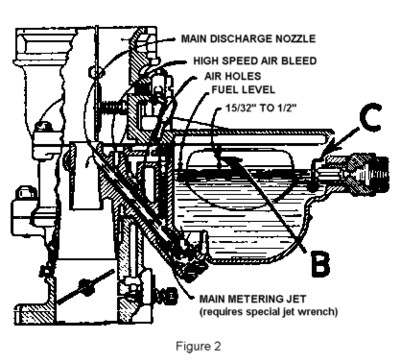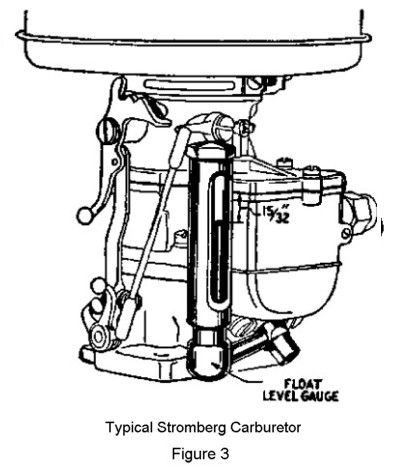|
Troubleshooting Ford and Stromberg Carburetors |
||||
|
|
||||
|
Home Parts Drawings Web Links Tune-Up & Service Serial Numbers Engine ID Trans ID Model Identification Terms of Sale Contact Us Our Online Store Our Catalog |
Stromberg Carburetors | |||
|
Ford used the Detroit Lubricator single barrel carburetor on the early V8 engines for 1932 and 1933. Beginning in 1934 production, Ford started using the Stromberg dual carburetor commonly known as the "97" which referred to the nominal venturi size of 0.97" diameter. Stromberg identified it as their Model EE-1. A slightly smaller version known as the "81" (Stromberg EE-7/8) was used on the smaller 60hp V8 engines from 1937 to 40. This carb was combined with the dual intake manifold so that each venturi fed half the cylinders of the engine. There are separate sets of venturi tubes, main metering systems, idle systems, throttle plates and pump discharge nozzles, and accelerating pumps. A single fuel chamber is used and air is taken through one air passage. The idle fuel system for one of these dual Stromberg carburetors is shown below in Figure 1. The idle adjustment screw is shown at A. Other details are shown in Figure 2. The place to measure the fuel level is indicated at B. Adjustment for altering the fuel level is made by bending the lip at C.
|
||||
|
|
The fuel level settings for the 97 or 81 Stromberg are 15/32" minimum and 17/32" maximum. The level of the fuel should be set to a distance of 15/32" below the machined surface at the top of the fuel bowl (with the engine running at idle speed). A special gauge was used to check for fuel level (see Figure 3) which was placed in the fuel drain plug hole of the carburetors. The engine was allowed to run at idle speed. The level shown in the gauge is the same as that present in the fuel bowl. If a gauge like this is not available, a steel rule may be used instead, measuring from the top edge of the bowl, with its cover removed, to the top of the fuel itself. Note that the car should be level for this test. It is also recommended that the fan belt should be loosened or removed for the test as the blast of air from the fan can affect the reading of the test. Also, fuel levels will drop up to 1/4" under high speed operation. Another method of testing the float level and needle valve is to perform the test without the engine running. To do this you would have to set up an electric fuel pump (use a pressure regulator to keep within specified pressure range) to supply gas to the carburetor. You would bypass the mechanical fuel pump and run a line from a fuel tank directly to the carb inlet fitting. Make sure the engine's ignition system is OFF. Power the electric fuel pump and check the fuel level with the top off the carb. Make sure to drain down the fuel level in the bowl to about half. This allows the pump to deliver fuel and see where the needle valve shuts it off. |
|||
|
High fuel pressure can account for high fuel levels, so the fuel pressure should be checked to make sure it is not excessive for any speed. Fuel level is controlled by both the float valve and the fuel pump pressure. As the valve becomes worn, the fuel level rises. If the seat is not too badly worn or damaged and is clean, the fuel level may be corrected by bending the lip of the float arm until the level is correct. To test for fuel pressure, attach a pressure gauge to the output side of the fuel pump. Start the motor without racing it, and observe the pressure at idle speed. Next, race the motor for a moment and again observe the pressure reading on the gauge. This pressure should not be less than 1½ lbs nor more than 3½ lbs at any speed. If outside these limits, the fuel pump should be adjusted, overhauled, or replaced. On carburetors that have accelerating pumps, adjust the stroke to suit the season. Note: some Stromberg 97's do not have the S or W settings (summer or winter) on the throttle linkage. Set the idle speed. If, when a vacuum test gauge is removed and the windshield wiper hose reconnected, the mixture is too lean, there is a leak in the wiper line somewhere, which must be corrected. If the carburetor has been disassembled for cleaning or any other purpose, it is easy to approximate an adjustment for starting the motor. On Stromberg carburetors adjust cold by turning the idle fuel adjustment screws (D) all the way in and then backing out 5/8 of a turn. If your carburetor cannot be adjusted for proper operation, it may require a rebuild by a competent technician, who is experienced in repairing the Stromberg carburetor. A simple cleaning and re-gasketing may not correct a carburetor with these and other defects. Worn throttle shafts and butterflies, leaking fuel floats, worn needle valve, clogged passages, warped castings, and other internal problems can best be corrected by someone with the correct tools, replacement parts, and repair knowledge. |
||||
|
Exploded Parts Drawing of Stromberg Carb Return to Flathead V8 Fuel Systems Page Copyright 2023 - VANPELT SALES LLC - All rights reserved |
||||



